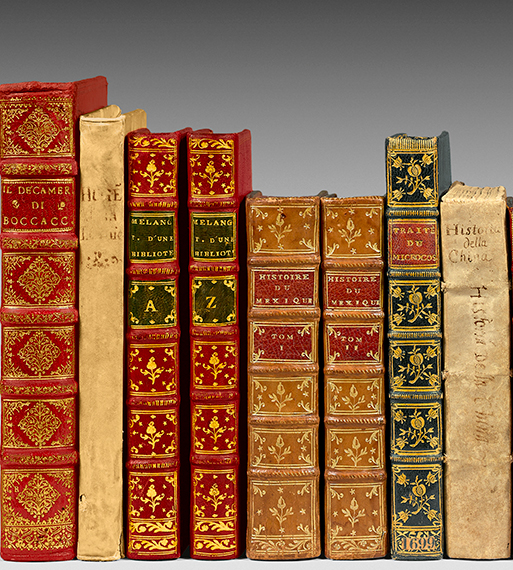The Island Atlas of Jacques d aAuzoles Lapeyre and the Creation of the World.
Auzoles Lapeyre, Jacques d a. The Sacred Geography, that is to say Exact Description of the Earth, and True Demonstration of the Earthly Paradise, From the Creation of the World Until Now: according to the literal sense of the Holy Scripture, & according to the Doctrine of the Holy Fathers & Doctors of the Church.
Paris, Antoine Estienne, 1629.
Folio of (6) ff., 224 pp., (22) ff., numerous figures and maps in text, crossed-out manuscript ex libris on title. Soft vellum, smooth spine with title stamped in gold. Binding of the time.
359 x 246 mm.
Original edition of this unique and very rare work, composed by someone who was considered in his time as the Prince of Chronologists.
Renouard, 219:7.
The author, who was secretary to Henry of Bourbon, Duke of Montpensier (1573-1608), converted to Catholicism in 1596.
In this work, he aims to show that geography 8is all drawn from the pure text of the Holy Scripture999 and he therefore follows the biblical chronology that he illustrates with striking figures.
Thus, we follow the evolution of the Earth from the original chaos (in a black circle) to the seventh day (where the four rivers of creation outline what resembles the contours of the continents…). Everything changes with the flood that disrupts this beautiful arrangement, creating continents and leaving a disfigured land.
To locate the different parts of the Earth according to the Holy Scriptures, the author draws on information from Genesis and the doctors of the Church to specify where Eden or the earthly paradise was located. He places there the rivers that ran through it, the location of Adam’s home, the Tree of Knowledge, etc.
9aThe Sacred Geography that Jacques d9aAuzoles-Lapeyre publishes in Paris in 1629 is so named 18because it is entirely drawn from the pure text of the Holy Scripture, or from the doctrine of the Fathers and Doctors of the Holy Church9.
The ambition of this geographer in the time of the Counter-Reformation is indeed to show that all Pagan science is contained in advance and according to the literal sense in Holy Scripture, illuminated by the lights of the Church. The fact is that profane geographers 18teach us nothing that is not contained in the Holy Books99, but 18having taken from them what they teach us, they merely disguise the subjects and tell us the same things in many and different languages99.
This sacred geography, adorned with numerous maps, is diachronic. It shows at a glance 18the various changes in the form and figure of the Earth, both before the flood and after it, and up to now99. Some parts of the work, by their sequence of maps and figures, resemble a kind of cartographic comic strip. We see the original chaos give way to the progressive order of Creation, over the first six days. A uniform black circle represents, with clear schematism, the original chaos. This blind disc quite aptly symbolizes the 18form, formless, of the world99. 9aSuch was, assures d9aAuzoles-Lapeyre, the face of the Universe, as we can represent it, covered in darkness.99
The separation of light and darkness is no less easy to depict: it will be a half-and-half disc, white and black, the upper half illuminated and the lower half ink black. This disc of light and shadow includes the concentric circles of the elements, water, air, and fire, and those of the planets. The latter, and for good reason, are still empty. The geocentric structure is ready and only awaits to be filled. The pure abstraction born of divine understanding thus precedes the materialization of the world, or at least its realization.
Then, the Second Figure of the World since the Created Light sees the brightening of the lower hemisphere. Above, an oval and slightly flattened sun projects its light from the fourth sky. Only the shadow cast by the Earth remains, which extends only in a pyramid to the second Heaven, which is the Heaven of Mercury, a dark truncated cone raised on its point. With the third day comes the distinction of the earth and the waters. From a single source located at the top of the map, the watercourses, four, then twelve, diverge like a fan across the regularly planted land of shrubs, a kind of universal orchard, to discharge below into the sea reduced to a puddle.
The great idea of9aAuzoles-Lapeyre, which he readily repeats, is that by the Flood the form and face of the Earth have changed, if not entirely, at least in part. The Earth, originally, was larger than the sea, much larger. The 18Map of the World before the Seventh Day proves this truth taught by the Apocalypse of Esdras: six-sevenths of the Earth are emerged and form a solid block. From the circular fountain located at the center of the world flow the four rivers of Paradise, which irrigate the entire immense primitive continent [ c]
This is the main assertion of d9aAuzoles-Lapeyre, confirmed by geographical reasons and expounded in the successive maps of his 18Sacred Geography: the Earth, originally, was just a vast continent surrounded by a fringe of sea. The mountains and valleys that threaded it 18did not prevent the Earth from being all contiguous and round on its surface, and all gathered in itself and circularly surrounded by the Sea.
Now, the Flood, by sanctioning the sin of men, disrupted this primordial geographical order, reversing the proportion of the Earth and water and aggravating the accidents of the terrain. The author of the Sacred Geography reasons thus: if the slightest earthquake is capable of bringing about rivers, lakes, ponds, where there were never any, 18what ought we to think the Flood, sent expressly to destroy the Earth, did99? The Flood dissociated the single primitive continent, it opened gaps and chasms everywhere, restricting on the globe’s surface the part left to man. In other words, the Flood engendered the islands [93]
In the introduction to his 18Isolario dell9aAtlante Veneto, published in Venice in 1691, Father Vincenzo Coronelli will record, not without reluctance or regret, the hypothesis of9aGiacomo d9aAuzoles-Lapeyre, a French-language author of a volume of Sacred Geography. It is impossible for Coronelli to subscribe to the negative judgment of d9aAuzoles Lapeyre concerning the islands. From the archipelago, the Venetian retains not the gaps and voids, but the points and solids, the milestones aligned across the sea and the bridges thus prepared for man to circulate over the entire globe’s surface91 (A. Cabantous, Sea and Mountain in European Culture).
There are two ways to conceive the origin of the islands. In the 17th century, Jacques d9aAuzoles-Lapeyre’s atlas, The Sacred Geography, claims to show, day by day, the creation of the world according to the account in Genesis. It is about aligning geography with Holy Scripture, rather than the reverse. At the beginning, the Earth is a black circle. Gradually, this chaos becomes orderly: God creates light, and half of the world lights up. Then the elements divide and distribute on the surface: water separates from the earth. For Jacques d9aAuzoles-Lapeyre, it is beyond doubt that, originally, the world formed a single continent. The image of the world we know with its seas and islands would be a consequence of original sin. Firstly because the entire nature was degraded by the fault of the first man. Secondly because the sins of successive generations aggravated this first fault, especially the crimes of the Giants which are the cause of the Flood. Jacques d9aAuzoles-Lapeyre does not hesitate to map it: the entire Earth is covered with small regular waves, with Noah’s ark floating in the middle. As the water receded after forty days, it revealed an unexpected image of the world: the emerged lands had shrunk and fragmented. D9aAuzoles-Lapeyre thus traces the origin of the islands to the Flood. The islands would mark the degradation of the world by the sin of man. This thesis is debated, notably by Coronelli, author of the Isolario del Atlante veneto, for whom islands are part of the holy diversity of the world and testify to the perfection of Creation. (Frank Lestringant)
Following this is a description of America, which could have been inhabited by the descendants of Shem, son of Noah, when this continent was still joined to Asia.
This edition is adorned with 21 engraved copper figures in the text showing in particular the various changes in the form and figure of the Earth, both before the flood and after it, and until now.
Precious copy preserved in its soft vellum of the time.

